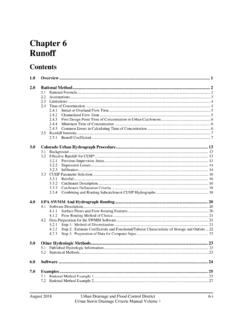Transcription of APPENDIX F – RATIONAL METHOD - Oregon
1 Hydrology 7-F-1 APPENDIX F RATIONAL METHOD Introduction One of the most commonly used procedures for calculating peak flows from small drainages less than 200 acres is the RATIONAL METHOD . This METHOD is most accurate for runoff estimates from small drainages with large amounts of impervious area. Examples are housing developments, industrial areas, parking lots, etc. The RATIONAL METHOD is included in the HYDROLOGIC module of the FHWA's Watershed Modeling System computer software package and a RATIONAL METHOD calculator is available within the FHWA Hydraulics Toolbox program. Input data such as runoff coefficients , rainfall information, etc., should be based on the procedures and information in the ODOT Hydraulics Manual when using this program. RATIONAL Equation The RATIONAL METHOD (or RATIONAL Formula) is: Q = Cf C i A (Equation 1) Where: Q = Peak flow in cubic feet per second (cfs) Cf = runoff coefficient adjustment factor to account for reduction of infiltration and other losses during high intensity storms C = runoff coefficient to reflect the ratio of rainfall to surface runoff i = Rainfall intensity in inches per hour (in/hr) A = Drainage area in acres (ac) Limitations and assumptions in the RATIONAL METHOD are as follows: The drainage area should not be larger than 200 acres.
2 The peak flow is assumed to occur when the entire watershed is contributing runoff . The rainfall intensity is assumed to be uniform over a time duration equal to or greater than the time of concentration, Tc. The peak flow recurrence interval is assumed to be equal to the rainfall intensity recurrence interval. In other words, the 10-year rainfall intensity is assumed to produce the 10-year flood. April 2014 ODOT Hydraulics Manual 7-F-2 Hydrology Detailed descriptions of the RATIONAL METHOD input variables follow: runoff Coefficient "C" - This variable represents the ratio of runoff to rainfall. It is the most difficult input variable to estimate. It represents the interaction of many complex factors, including the storage of water in surface depressions, infiltration, antecedent moisture, ground cover, ground slopes, and soil types. In reality, the coefficient may vary with respect to prior wetting and seasonal conditions.
3 The use of average values has been adopted to simplify the determination of this coefficient. Table 1 lists runoff coefficients for various combinations of ground cover and slope. Where a drainage area is composed of subareas with different runoff coefficients , a composite coefficient for the total drainage area is computed by dividing the summation of the products of the subareas and their coefficients by the total area: The impervious surface area is often a factor in stormwater storage and water quality treatment designs. Impervious surfaces have runoff coefficients greater than based on Table 1. These are hard surfaces which either prevent or significantly retard the entry of water into the soil mantle. Common impervious surfaces include, but are not limited to, roof tops, walkways, patios, driveways, parking lots or other storage areas, concrete or asphalt paving, gravel roads, packed earthen materials, oiled, macadam, or other similar surfaces.
4 runoff Coefficient Adjustment Factor "Cf" - The coefficients in Table 1 are applicable for 10-years or less recurrence interval storms. Less frequent, higher intensity storms require adjusted runoff coefficients because infiltration and other losses have a proportionally smaller effect on runoff . runoff coefficient adjustment factors (Cf) for storms of different recurrence intervals are listed in Table 2. Rainfall Intensity "i" - This variable indicates rainfall severity. Rainfall intensity is related to rainfall duration and design storm recurrence interval. Rainfall intensity at a duration equal to the time of concentration (Tc) is used to calculate the peak flow in the RATIONAL METHOD . The rainfall intensity can be selected from the appropriate intensity-duration-recurrence interval (I-D-R) curve in APPENDIX A. Area "A" - The area is defined as the drainage surface area in acres, measured in a horizontal plane.
5 The area is usually measured from plans or maps using a planimeter. The area includes all land enclosed by the surrounding drainage divides. In highway drainage design, this area will frequently include upland properties beyond the highway right-of-way. ()()2)(Equation AA C C CompositeArea TotalAreas IndividualAreas Individual =ODOT Hydraulics Manual April 2014 Hydrology 7-F-3 Table 1 runoff coefficients for the RATIONAL METHOD FLAT ROLLING HILLY Pavement & Roofs Earth Shoulders Drives & Walks Gravel Pavement City Business Areas Apartment Dwelling Areas Light Residential: 1 to 3 units/acre Normal Residential: 3 to 6 units/acre Dense Residential.
6 6 to 15 units/acre Lawns Grass Shoulders Side Slopes, Earth Side Slopes, Turf Median Areas, Turf Cultivated Land, Clay & Loam Cultivated Land, Sand & Gravel Industrial Areas, Light Industrial Areas, Heavy Parks & Cemeteries Playgrounds Woodland & Forests Meadows & Pasture Land Unimproved Areas Note: Impervious surfaces in bold Rolling = ground slope between 2 percent to 10 percent Hilly = ground slope greater than 10 percent April 2014 ODOT Hydraulics Manual 7-F-4 Hydrology Table 2 runoff Coefficient Adjustment Factors RECURRENCE INTERVAL runoff COEFFICIENT ADJUSTMENT FACTOR 10 years or less 25 years 50 years 100 years Time of Concentration "Tc" - The time of concentration (Tc), is defined as the time it takes for runoff to travel from the hydraulically most distant point in the watershed to the point of reference downstream.
7 Most drainage paths consist of overland flow segments as well as channel flow segments. The overland flow component can be further divided into a sheet flow segment and a shallow concentrated flow segment. Urban drainage basins often will have one or more pipe flow segments. The travel time is computed for each flow segment and the time of concentration is equal to the sum of the individual travel times, as follows: Tc = Tosf + Tscf + Tocf + Tpf (Equation 3) Where: Tc = Time of concentration in minutes (min.) Tosf = Travel time for the overland sheet flow segment in minutes (min.) Tscf = Travel time for the shallow concentrated flow segment in minutes (min. ) Tocf = Travel time for the open-channel flow segment(s) in minutes (min.) Tpf = Travel time for the pipe flow segment(s) in minutes (min.) The drainage path used to determine the time of concentration need not include all of the listed segments.
8 As an example, a roadway pavement bounded by curbs and drained by an inlet connected to a storm drain will have segments of overland sheet flow (pavement), open-channel flow (gutter), and pipe flow (storm drain). There is no shallow concentrated flow segment. The travel times for the flow segments are determined as follows. Overland Sheet Flow - Overland sheet flow is shallow flow over a plane surface. It occurs in the furthest upstream segment of the drainage path, which is located immediately downstream from the drainage divide. The length of the overland sheet flow segment is the shorter of: the distance between the drainage divide and the upper end of a defined channel, ODOT Hydraulics Manual April 2014 Hydrology 7-F-5 or a distance of 300 feet. The overland sheet flow velocity is usually slower than the velocities further downstream. The kinematic wave equation can be used to estimate the time of concentration associated with overland sheet flow.
9 The equation is shown below, and it is only applicable for travel distances equal to or less than 300 feet. Where: Tosf = Travel time for the overland sheet flow segment in minutes (min.) L = Length of the overland sheet flow segment in feet (ft) n = Manning's roughness coefficient (See Table 3) i = Rainfall intensity in inches per hour (in/hr) See APPENDIX A. S = The average slope of the overland area in feet per feet (ft/ft) Note: Calculating the time of concentration for overland sheet flow is an iterative or trial and error solution because both the flow time and the rainfall intensity are unknown. The procedure is illustrated in the Example. Table 3 Manning's Roughness coefficients for Overland Sheet Flow (Maximum Flow Depth = 1 inch) Pavement & Roofs City Business Areas Graveled Surfaces Apartment Dwelling Areas Industrial Areas Urban Residential Areas (more than 6 units acre) Meadows, Pastures & Range Land Rural Residential Areas (more than 6 units acre) Playgrounds, Light Turf Parks & Cemeteries, Heavy Turf Woodland & Forests Shallow Concentrated Flow - Overland sheet flow often becomes either shallow concentrated flow or open-channel flow as it progresses down the drainage.
10 It becomes 4)(Equation )S(i) (L 2014 ODOT Hydraulics Manual 7-F-6 Hydrology shallow concentrated flow if it enters a shallow or poorly defined channel such as a gully or rill. The average shallow concentrated flow velocity can be approximated using Figure 1, in which the velocity is a function of the watercourse slope and the surface type. The travel time for the shallow concentrated flow segment is calculated by the following formula: Where: Tscf = Travel time for the shallow concentrated flow segment in minutes (min. ) L = Length of the shallow concentrated flow segment in feet (ft) V = Average flow velocity in feet per second (ft/s), as shown in Figure 1. Note: This figure is from the 1972 Soil Conservation Service Handbook . Open-Channel and Pipe Flow - Overland sheet flow, or shallow concentrated flow, becomes open-channel flow when it enters a defined channel with known cross-sectional geometry, a channel visible on aerial photographs, or a channel indicated by a blue line on a USGS - minute quadrangle map.

















